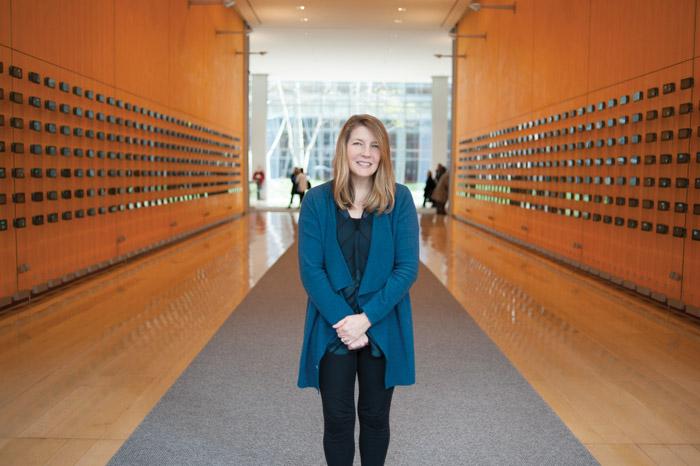A Room of Her Own

Photo by Anna Herbst
by David McKay Wilson
The day after one of the sell-off of Chinese stocks roiled the international market, Susan Ellingwood ’87 sits with a note pad at the morning meeting of The New York Times’ top editors.
Ellingwood, who edits the media company’s Room for Debate feature, discusses the latest news with her team of three and decides what topic they’ll choose to spark an online conversation among readers from around the world. They’ll seed that discussion by soliciting unpaid 300-word essays from experts on their selected issue.
That day, her team whips up a debate on stock-market volatility, by posing the question: With Markets in Flux, Should We Panic or Have Patience? By the next day, essays are posted from five economic experts, including a capital analyst in Singapore, a Chinese professor of international management at MIT and U.S. economists from across the political continuum.
“We want the liberal view, the conservative view, as well as the voices of minorities,” says Ellingwood, who lives in Manhattan’s Washington Heights neighborhood, with husband Jake, daughter Beatrice and son Hiker. “We want it to be cocktail conversation, so you’ll be up on the latest views on the news.”
Ellingwood’s team works on the 13th floor of the Times’ high-rise headquarters on 8th Avenue, a few blocks from Times Square. Ellingwood has a window seat, at a desk piled high with books. There are biographies of J.D. Salinger and Stokely Carmichael, a book on English usage and Taylor Branch’s history of the civil rights struggle.
Room for Debate has emerged as one of the paper’s popular online features, with its wide-ranging coverage of public affairs. Questions run the gamut, with higher education often in the mix. The top 10 most reader-discussed debates from 2015 included: Does the Confederate Flag Breed Racism? Is the Fight Against ISIS the West’s Fight? [What Happens When] A Generation Becomes Less Tolerant of Free Speech?
“Susan has created the best work environment I’ve ever had,” says Times editor Nick Fox, who works with Ellingwood to develop the questions, find the experts, edit the essays and then post them. “We have great discussions that ramble on in a very productive way. And the work ends up getting done.”
Ellingwood’s journalism career dates back to 1994, when she joined The New Yorker as an assistant to Washington Bureau Chief Michael Kelly. An international relations and Soviet studies major at Dickinson, Ellingwood met Kelly in 1993 while working at the Council on Foreign Relations, where she organized the council’s seminars with international experts while writing and editing various reports—including one on arms control—which she concedes landed largely in recycling bins. She yearned for a broader audience.
She wrote to a slew of big-name journalists, seeking advice on how to jump-start a career in the news business, which, at the time, was booming. Kelly, then writing a book about Yugoslavia, was the only one to reply.
“He took me under his wing,” recalls Ellingwood. “And he became like a brother to me.”
When Kelly moved to The New Republic, Ellingwood came along, eventually becoming the magazine’s assistant managing editor. Ellingwood’s next stop was as editor on the foreign news desk at The Wall Street Journal. Her team of correspondents included Daniel Pearl, who was reporting on the rise of radical Islam in Pakistan. There, she learned the art of working with journalists on assignment abroad.
“These people were away from their families, in foreign settings,” she says. “You had to be careful with your tone in the emails you sent them. You wanted to make sure, if you were cutting the piece, that you could still make them feel good. Writers have feelings, and egos.”
When Pearl was murdered in south Asia in 2002, Ellingwood became the editorial director at the Committee to Protect Journalists, a nonprofit organization that promotes press freedom worldwide. A year later, Kelly was killed while on assignment in Iraq.
“It was devastating,” says Ellingwood, whose daughter Beatrice was named for the nickname Kelly gave her. “We had to send out news alerts about his death. That was really tough.”
Ellingwood, it turns out, had professional training in the realities of war. She grew up an Army brat, with her father transferred to new postings during her early childhood before settling in New Hampshire. At Dickinson, she was one of five members of the ROTC program, later serving eight years in the U.S. Army Reserves. As “morale officer,” Ellingwood made sure soldiers’ files were in order, which meant having a will and next-of-kin notifications. The file often included a “last letter home,” written by a soldier to be given to family members upon his or her death.
Those letters came to mind after she landed a job on the Times opinion page, and she became one of the associate producers of the joint Times/HBO documentary Last Letters Home.
That project showed the opinion editors the breadth of her abilities and her range of interests. Her current posting fits her well—a mix of news and opinion, on the front lines of public affairs. Room for Debate goes live each morning at 3:30 a.m., which the newspaper’s digital team has concluded is the best time to develop an online audience throughout the day.
“There are growing pains when you have to think digital, but the Times is very much in the game,” she says. “Still, we can’t be so obsessed with click-bait. People need to know what’s going on in the world.”
Learn More
Read more from the winter 2016 issue of Dickinson Magazine.
Published January 29, 2016